From haunted highways to cursed islands, these spots are real

1. The Bunny Man Bridge – Fairfax County, Virginia
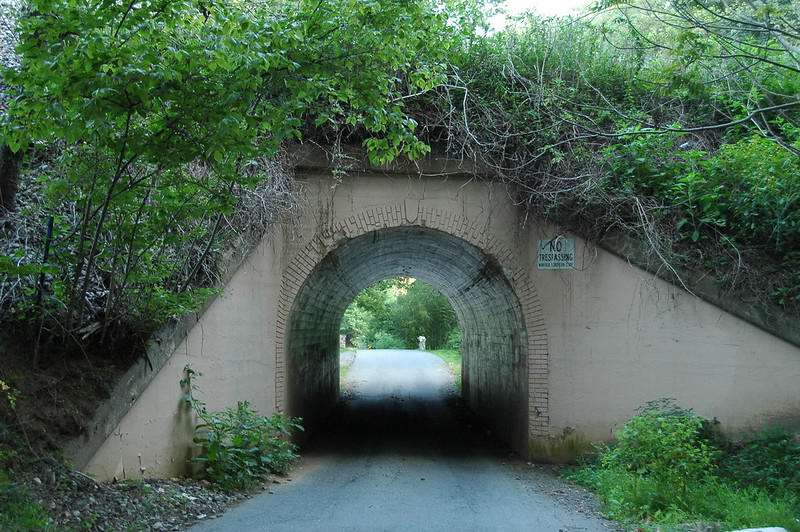
Tucked deep in the woods of Fairfax County, Virginia, the Colchester Overpass, now infamously called Bunny Man Bridge, has become the epicenter of one of the nation’s eeriest urban legends. The most common version of the story involves an escaped mental patient from a nearby asylum who, dressed in a white bunny costume, terrorized the area in the 1970s. According to local lore, he wielded an axe, slaughtered animals, and left their bodies hanging from the trees surrounding the overpass. On Halloween night, it’s said he still appears, bloodstained and waiting, ready to punish trespassers. Some versions even claim the original Bunny Man was hit by a train while hiding in the tunnel and now haunts it with a vengeful spirit. The bridge has become a popular destination for teens to dare each other, especially in October. Many people report hearing strange noises, seeing flickering lights, and experiencing an overwhelming sense of being watched. It’s not just a campfire tale; it’s a cultural fixture.
What makes this story especially chilling is how close it veers to reality. In October 1970, two separate police reports described a man in a full bunny suit brandishing a hatchet and threatening locals near Fairfax. One incident involved him yelling at a young couple parked on a residential street, warning them to leave. The other took place at a nearby construction site, where he allegedly chopped at a porch post. Both were reported to the authorities, and local newspapers picked up the story, giving rise to the legend. Though the man was never caught or identified, the documented sightings fueled public paranoia. Over time, the tale morphed from unsettling truth to full-blown horror folklore. Despite the passage of decades, Bunny Man Bridge still attracts thrill-seekers, paranormal investigators, and skeptics alike, drawn to a place where fact and fiction are forever tangled. Source: The Washingtonian
2. Isla de las Muñecas (Island of the Dolls) – Xochimilco, Mexico
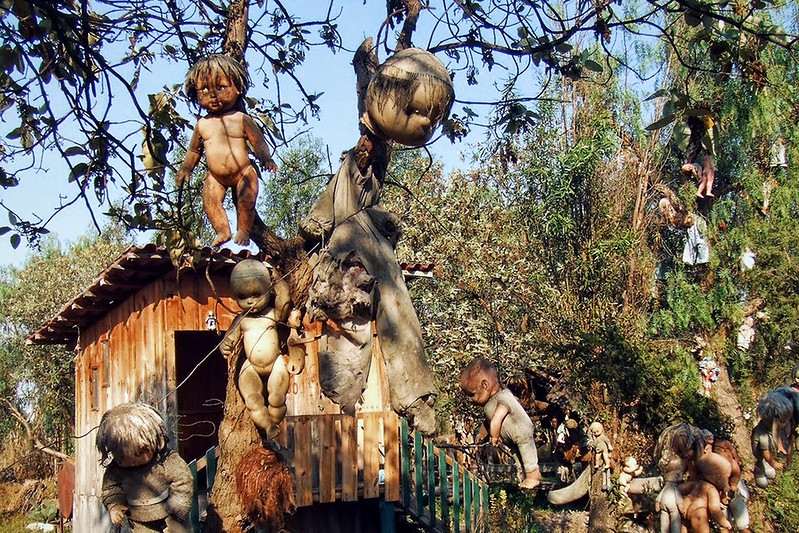
Deep in the canals of Xochimilco, just outside Mexico City, floats one of the most unsettling places in the Western Hemisphere. Known as the Island of the Dolls, it is covered in hundreds of deteriorating dolls strung from tree branches, tied to fences, and nailed to rotting huts. Most are missing limbs, eyes, or heads, and many are covered in mold or insect nests. The legend began in the 1950s when the island’s sole caretaker, Don Julián Santana Barrera, claimed to have discovered the body of a drowned girl nearby. Not long after, he began hearing voices and footsteps he could not explain. Believing the girl’s spirit was haunting him, he started hanging old dolls throughout the island as a form of protection or offering. He found them in garbage heaps or traded vegetables for them in town. Over time, the island became a disturbing landscape of lifeless eyes and faded plastic smiles.
Even more chilling is how the story ends. In 2001, Don Julián was found dead, floating in the same canal where he believed the girl had died decades earlier. Some believe the dolls finally claimed him, while others suggest he was overcome by isolation and obsession. Since his death, the island has drawn ghost hunters, journalists, and thrill-seekers, many of whom report hearing whispers or feeling cold touches. Some visitors claim to see the dolls move or change positions when no one is looking. Others describe an overwhelming sense of dread that begins the moment they dock. Though the island is now a popular tourist destination, most locals refuse to go near it. For them, the dolls are not just symbols of sorrow. They are still listening. Source: BBC
3. Aokigahara Forest – Yamanashi Prefecture, Japan

At the base of Japan’s iconic Mount Fuji lies Aokigahara, a dense, moss-covered forest with an international reputation for silence and sorrow. Known as the “Sea of Trees,” it is eerily quiet due to the volcanic soil absorbing sound and a thick canopy that blocks wind. But Aokigahara is more than a natural oddity; it is also one of the most infamous suicide locations in the world. For decades, it has drawn people in despair, many of whom never leave. Signs at the forest entrance plead with visitors to seek help and reconsider their choices. Local volunteers regularly sweep the area for bodies, and paths marked with police tape often indicate where someone has gone missing. Some hikers carry twine to avoid getting lost, tying it to trees as they progress deeper into the wilderness. The deeper you go, the more the forest seems to swallow sound and, with it, reason.
The origins of its dark reputation go beyond recent tragedies. Aokigahara has long been associated with Japanese folklore, particularly yūrei, restless spirits of the dead who met violent or unresolved ends. Centuries ago, it was rumored to be a site of subacute, a practice in which elderly family members were left to die in remote locations during famines. Although historians debate whether that ritual ever took place here, the belief persists. In modern times, the forest’s grim association grew after the publication of Kuroi Jukai, a 1960 novel that depicted a tragic suicide within the woods. Today, tourists visit both for its natural beauty and its haunted lore. Many report hearing whispers or encountering strange cold spots without warning. To some, Aokigahara is a forest of legend. To others, it is a place where the veil between the living and the lost grows dangerously thin. Source: National Geographic
4. Château de Brissac – Brissac-Quincé, France
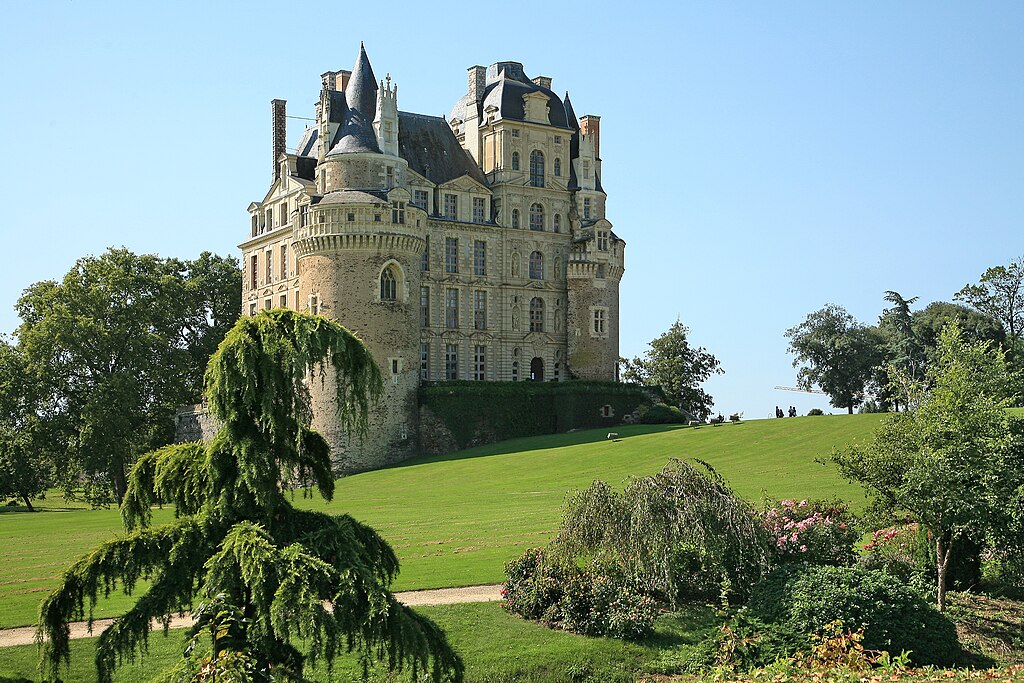
Rising seven stories above the French countryside, the Château de Brissac is the tallest château in the Loire Valley and perhaps one of the most haunted. Behind its opulent Renaissance façade lies a grim tale from the 15th century. According to legend, Charlotte de Brézé, the illegitimate daughter of King Charles VII, was murdered in the castle by her husband after he discovered her affair. Some versions say she was stabbed to death in her bedroom. Others suggest she was strangled in the chapel. But nearly all the accounts agree on one thing: her restless spirit still lingers. She became known as the “Green Lady” due to the green dress she was reportedly wearing at the time of her death. Over the centuries, guests and staff have reported seeing a ghostly woman with hollow eye sockets and a green gown roaming the halls at night.
Visitors claim to hear wailing from the tower rooms and doors slamming on their own. Some have even fled in the middle of the night after seeing her apparition appear at the foot of their beds. Despite the disturbing reports, the château remains a private residence, having been owned by the same family for over 500 years. They’ve embraced its eerie past, even offering ghost-themed tours to curious travelers. The haunting has become part of the property’s identity, woven into its creaking staircases and candlelit corridors. Whether you believe in spirits or not, the combination of royal scandal, centuries-old architecture, and unexplainable phenomena makes Château de Brissac feel like a place where time and tragedy never truly left. Source: Conde Nast Traveler
5. The Tower of London – London, England

Few places in the world hold as much blood-soaked history as the Tower of London. Originally built by William the Conqueror in the 11th century, the fortress has served as a royal palace, an armory, a prison, and an execution site. Over the centuries, it became the final stop for some of Britain’s most famous figures, including Anne Boleyn, Sir Thomas More, and Lady Jane Grey. Beheadings took place within the tower walls and on the nearby Tower Green, and their ghosts, it seems, never truly left. Anne Boleyn’s spirit is the most frequently reported. Guards and visitors have claimed to see her wandering the chapel where she is buried, sometimes holding her head in her hands. Others describe a strange, suffocating coldness in certain chambers and the sensation of being watched by unseen eyes.
Even the tower’s ravens, symbols of national protection, are wrapped in legend. It is said that if they ever abandon the fortress, the kingdom will fall. Today, their wings are clipped to ensure they stay. The tower’s ghostly reputation is so strong that even Yeoman Warders, the guards who live on site, are trained to deal with paranormal encounters. Over the years, they’ve reported unexplainable footsteps, vanishing figures in Tudor dress, and disembodied screams echoing through the stone walls. With over 1,000 years of royal intrigue, betrayal, and death layered into its foundation, the Tower of London is less a monument than a haunted archive of England’s darkest chapters. Source: Britannica
6. Poveglia Island – Venice, Italy
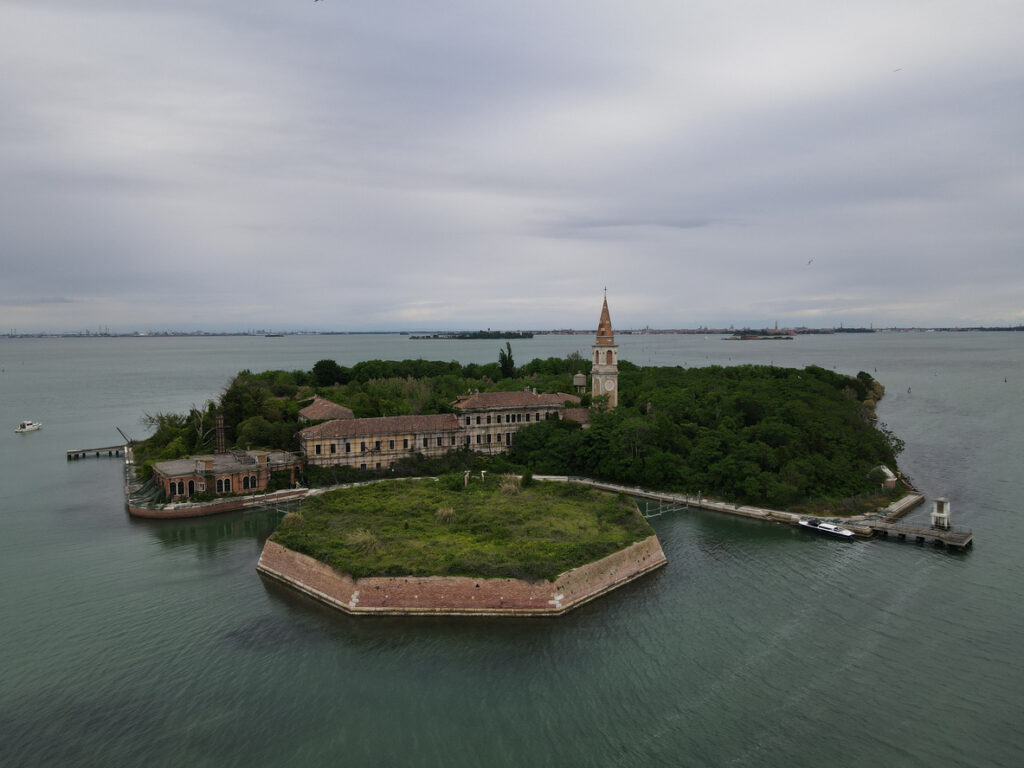
Just off the coast of Venice sits Poveglia Island, a place so steeped in fear that locals won’t set foot on it. Used as a quarantine station for plague victims in the 18th century, the island quickly became known as a floating graveyard. It is estimated that over 100,000 people died on the island, many of them buried in mass pits or burned on open pyres. When the Black Death returned to Venice, Poveglia was again used to isolate the sick and dying. Centuries later, in the 1920s, a mental hospital was constructed on the island, where patients reported seeing ghostly figures and hearing screams emanating from empty rooms. One doctor allegedly performed crude lobotomies and later jumped, or was pushed, from the hospital’s bell tower. The building has since crumbled into ruins, but the tower still stands, eerily quiet and covered in ivy.
Today, Poveglia is wholly abandoned and officially off-limits, though that hasn’t stopped thrill-seekers and paranormal investigators from sneaking onto its shores. Those who visit report overwhelming feelings of dread, sudden nausea, and unexplained bruises appearing on their bodies. Many describe hearing cries echoing across the island and seeing shadows dart between the decaying buildings. The ground is said to be made up of more ash than soil, the result of centuries of burning plague victims. Even fishermen steer clear of the island, fearing they’ll dredge up bones. Although the Italian government has attempted to auction it off multiple times, buyers have always seemed to back out. Whatever still lives there or doesn’t is enough to keep Poveglia in permanent exile. Source: Atlas Obscura
7. Hoia Baciu Forest – Cluj-Napoca, Romania
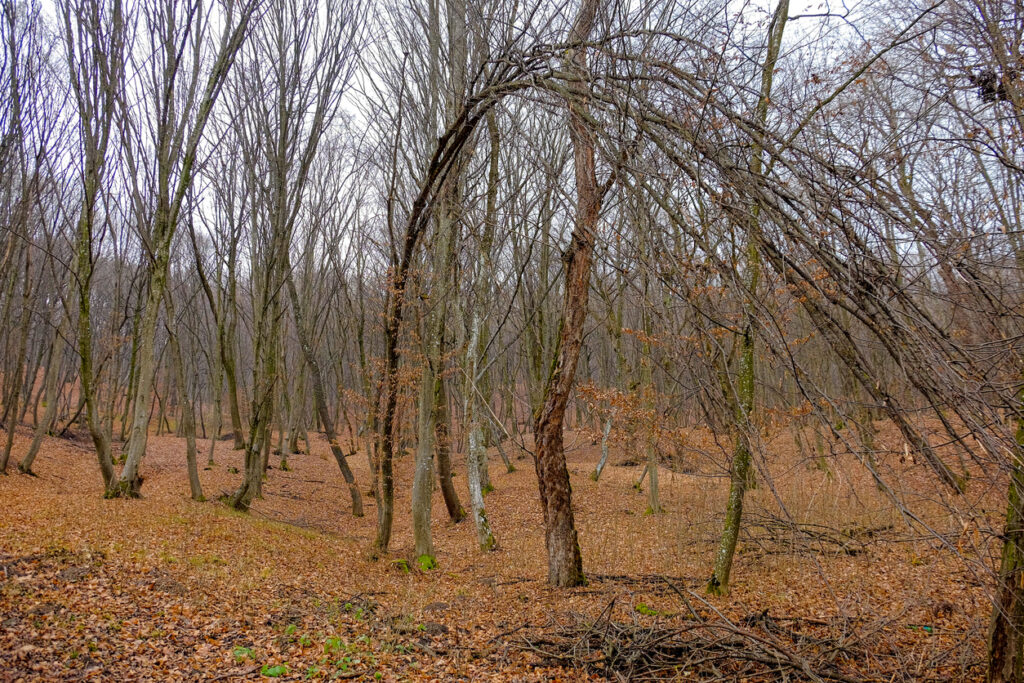
Dubbed the “Bermuda Triangle of Transylvania,” Hoia Baciu Forest is infamous for its twisted trees, inexplicable phenomena, and a deep sense of unease. Located just outside the city of Cluj-Napoca, the forest gained international attention in 1968 when a military technician snapped a photo of what appeared to be a UFO hovering above the trees. Since then, countless visitors have reported bizarre experiences, including feelings of anxiety, sudden nausea, missing time, and even spontaneous scratches or burns. Some claim to hear disembodied laughter, while others insist they’ve seen floating orbs or shadowy figures darting between the trees. In the heart of the forest lies a nearly perfect circular clearing where no vegetation grows despite healthy soil tests. Scientists have studied it, but no explanation has been confirmed.
Local legends long preceded the modern-day reports. Folklore speaks of peasants who vanished in the forest, never to return, and a five-year-old girl who disappeared only to reemerge years later, unchanged and unaware of what had happened. Paranormal investigators from around the world have descended on Hoia Baciu to test electromagnetic fields and document anomalies, but the mystery remains. Even seasoned researchers admit to losing equipment or experiencing distorted compass readings. Despite its sinister reputation, the forest draws thousands of curious hikers, ghost hunters, and spiritual seekers each year. Some leave shaken, others skeptical, but nearly all agree the energy is unlike anything they’ve felt elsewhere. Whether it’s mass hysteria, magnetic disturbance, or something more ancient and malevolent, Hoia Baciu holds its secrets tightly.
8. The Myrtles Plantation – St. Francisville, Louisiana

Nestled among Spanish moss and oak trees, The Myrtles Plantation in Louisiana is often called one of the most haunted homes in America. Built-in 1796, the antebellum estate has seen generations of tragedy, including murder, illness, and slavery. The most enduring legend involves an enslaved person named Chloe, who was allegedly punished by having her ear cut off after eavesdropping on her master’s conversations. Seeking revenge, she supposedly baked a poisoned cake that killed two of the family’s children. After her crime was discovered, other enslaved people hanged her and threw her body into the Mississippi River. Chloe is now said to haunt the plantation, often seen wearing a green turban to cover her missing ear. Visitors claim she appears in windows, mirrors, and photographs—some of which have gained notoriety for capturing her figure in chilling detail.
The plantation is said to house at least a dozen restless spirits, including Union soldiers, a murdered lawyer, and the ghost of a young girl who died from yellow fever. Some guests report hearing piano music in empty rooms or footsteps on the stairs when no one is there. Others have experienced cold spots, tugged bedsheets, or sudden emotional outbursts without explanation. Despite the ghostly activity, the Myrtles now operates as a bed-and-breakfast and offers regular tours. Staff are upfront about the legends and even keep a guestbook filled with firsthand paranormal accounts. Whether the stories are based on truth, myth, or a little of both, the atmosphere at Myrtles Plantation leaves many believing the past is still very much alive
9. Overtoun Bridge – Dumbarton, Scotland
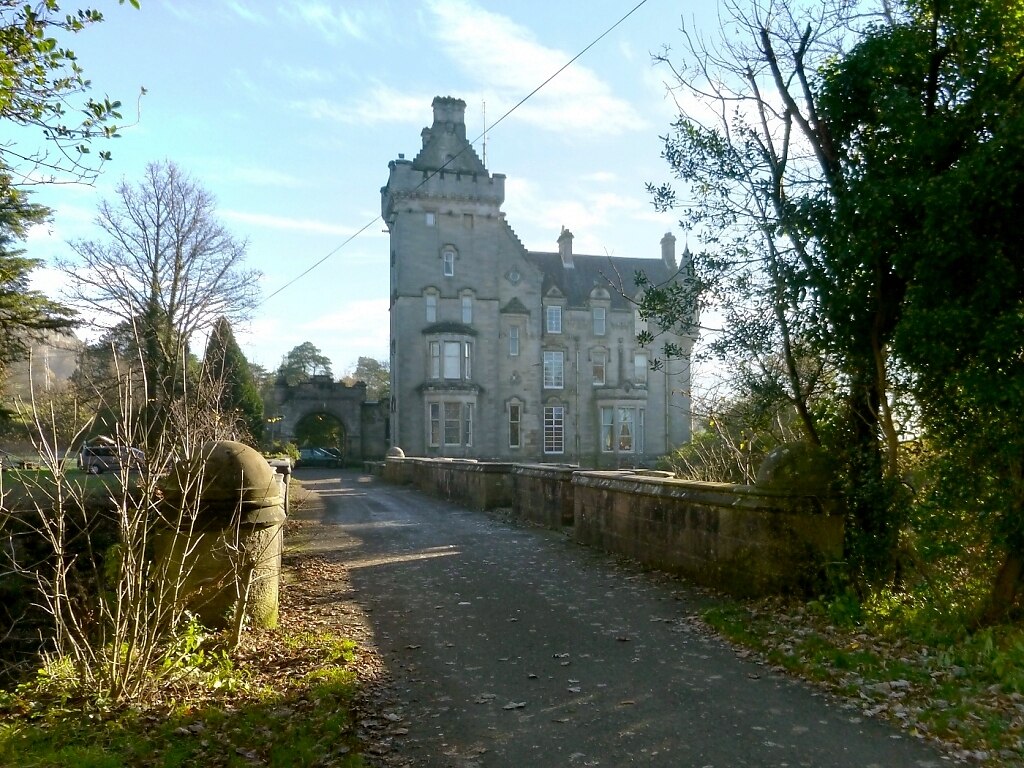
High above a rushing stream in the Scottish countryside, Overtoun Bridge has earned a disturbing nickname: the “Dog Suicide Bridge.” Since the 1950s, more than 50 dogs have leaped from the same side of the bridge, often on clear days and without warning. Some animals have survived the 50-foot fall only to climb back up and jump again. Most chilling of all, nearly every incident has occurred in the same exact spot, between the final two parapets on the right-hand side. Theories range from optical illusions caused by the bridge’s construction to the scent of mink attracting the dogs’ attention. But many locals believe something darker is at work—a malevolent presence or energy drawing creatures to their deaths.
The area itself has a long and strange history. Built in the 1800s near the Overtoun House, the bridge sits on land historically associated with supernatural lore. Some residents believe it rests on a “thin place,” a Celtic term for a location where the boundary between worlds is especially fragile. Others point to the ghost of Lady Overtoun, who is said to roam the grounds in grief after losing her husband in the early 20th century. Paranormal investigators have studied the bridge, but no conclusive explanation has been found. Even dog owners who cross it today are warned to leash their pets tightly. Whether psychological, environmental, or spiritual, the effect is undeniably real, and the mystery of Overtoun Bridge remains as eerie as it is unsolved. Source: Discovery UK
10. Manchac Swamp – Louisiana, United States
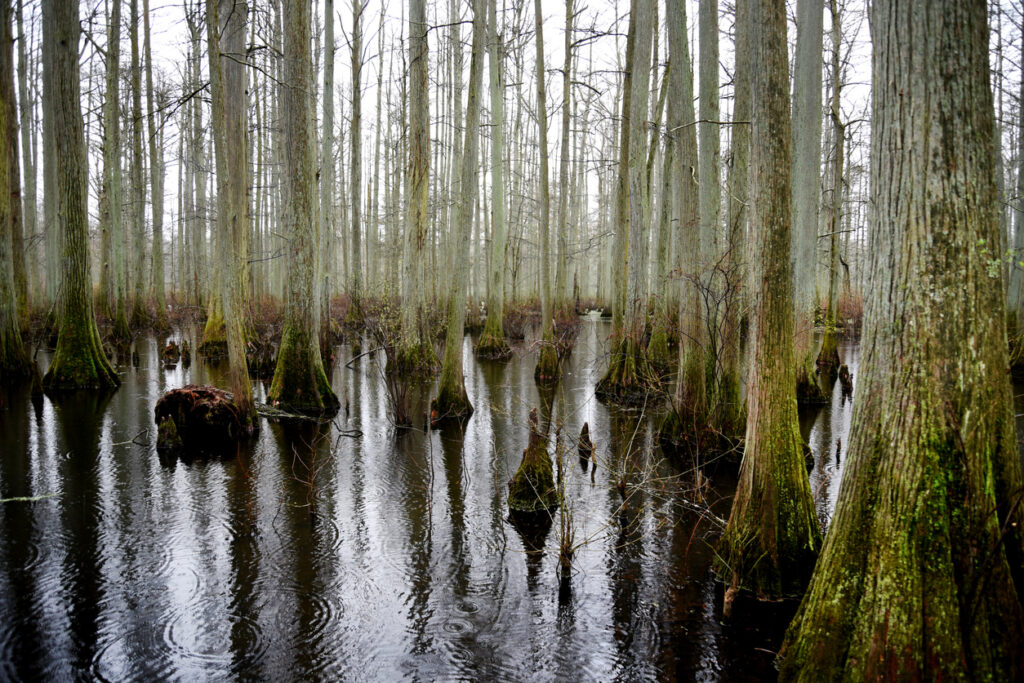
ust outside New Orleans lies Manchac Swamp, a stretch of murky water and tangled cypress trees that looks like it was designed for ghost stories. According to legend, the swamp is cursed and doomed by the final words of a Creole voodoo priestess named Julia Brown. In the early 20th century, Brown was known for her healing abilities but also for her growing bitterness toward the local townspeople. On the day of her funeral in 1915, a massive hurricane ripped through the region, destroying nearby villages and killing hundreds. Her eerie prophecy, reportedly sung in the days leading up to her death, “One day I’m gonna die, and I’m taking everyone with me,” seemed to come true. Many believe her restless spirit still lingers in the swamp, crying out from beneath the moss-draped trees.
The swamp is also known for its ghost sightings and unexplained sounds. Locals and visitors alike have reported hearing phantom screams, sloshing footsteps in empty water, and even glimpses of shadowy figures along the narrow trails. Some tour guides claim boats have stalled without mechanical reason or that sudden cold drafts strike on humid days. The remnants of destroyed towns, including the long-lost village of Frenier, still lie buried beneath the swamp’s surface, adding an archaeological weight to its legend. Though it’s now a popular spot for eco-tours, Manchac’s sinister atmosphere remains palpable. Between folklore, tragedy, and eerie terrain, the swamp has earned its reputation as one of the South’s most haunted natural wonders. Source: Smithsonian Magazine
11. Bhangarh Fort – Rajasthan, India
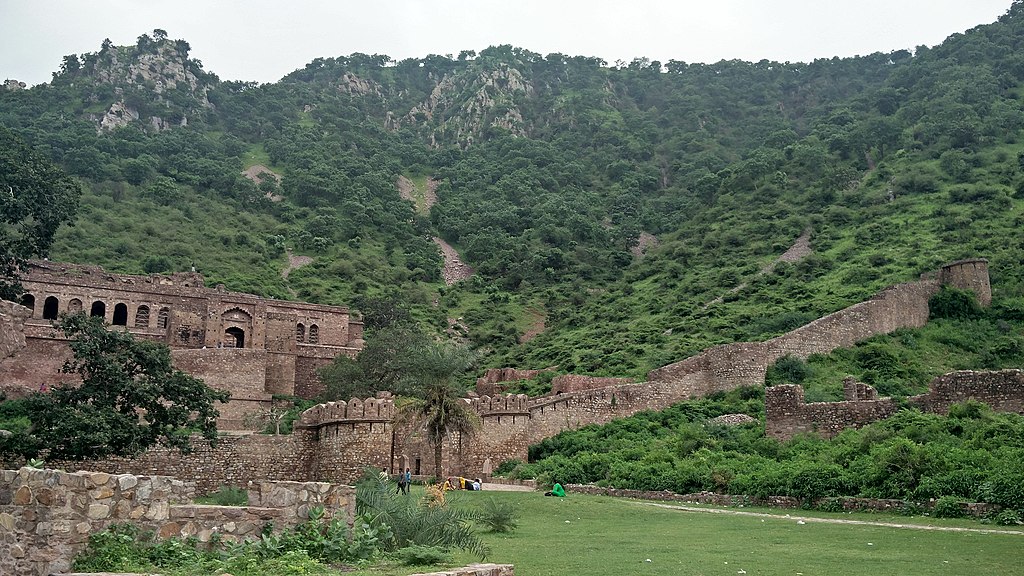
Often referred to as the most haunted place in India, Bhangarh Fort stands in eerie isolation at the edge of the Aravalli Hills. Built in the 17th century at the order of King Madho Singh, the fortress was intended to be a marvel of architecture and strength. But soon after its completion, it was abandoned, and the surrounding town collapsed into ruins. According to legend, a local sorcerer named Singhia fell in love with Princess Ratnavati and attempted to win her affection with a love potion. When she discovered his plan, she threw the potion against a boulder, which then rolled down and crushed him. With his dying breath, Singhia cursed the town and all who lived in it. A year later, a battle decimated the city, and it was never rebuilt. Locals believe the land remains cursed, and even the Archaeological Survey of India forbids entry after sundown.
Visitors to Bhangarh often report more than just eerie silence. Some claim to hear voices whispering from empty chambers or footsteps echoing down deserted hallways. Others describe sudden mood swings, dizziness, or fainting spells while exploring the site. Photographs sometimes capture ghostly figures or flickering lights within the old walls. Paranormal researchers have attempted to document the activity, but even seasoned investigators admit the energy inside the fort feels oppressive and strange. Though it is open to tourists by day, most people leave before dusk out of respect or fear. With a past woven from royal ambition, black magic, and mass tragedy, Bhangarh Fort is not just a ruin. It is a warning, standing silent under the Rajasthani sun. Source: BBC
12. Centralia – Pennsylvania, United States
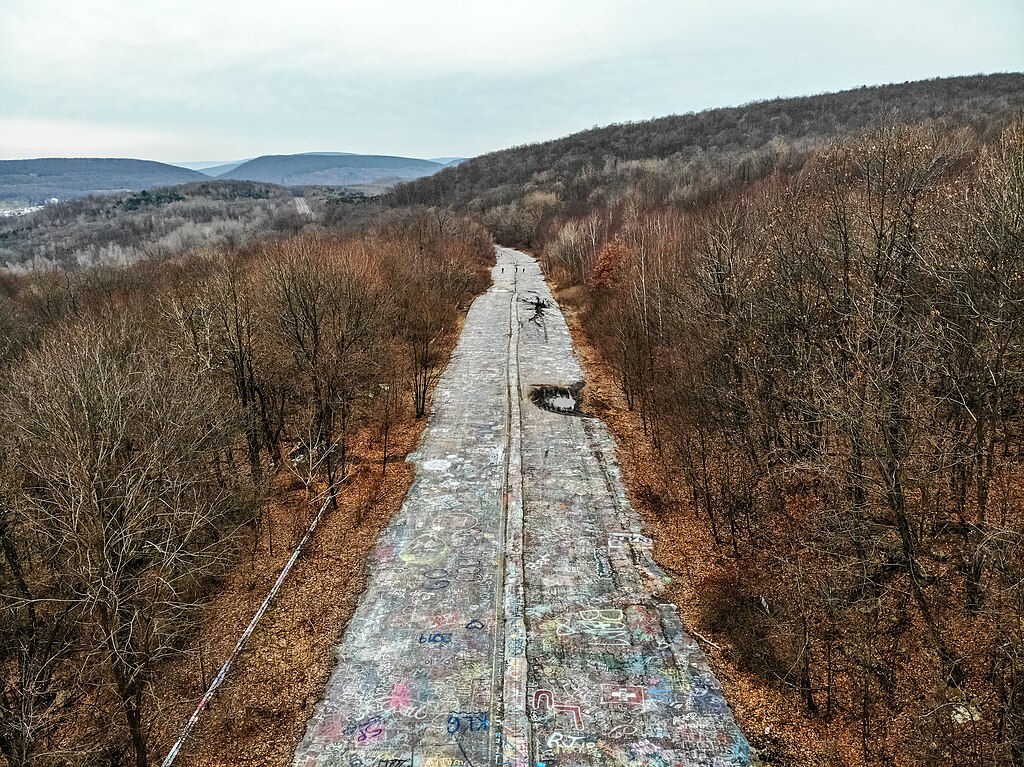
What was once a thriving mining town is now a ghostly wasteland of crumbling streets, buried homes, and smoldering earth. Centralia, Pennsylvania, became the inspiration for horror settings like Silent Hill, and for good reason. In 1962, a fire was accidentally ignited in an abandoned coal mine beneath the town. Authorities believed it could be contained, but they were wrong. The fire spread through underground coal seams, and by the 1980s, smoke and toxic gases began seeping through the ground. Roads buckled, a 12-year-old boy fell into a sinkhole in his backyard, and homes began to collapse. By 1992, the state declared eminent domain, evacuated the remaining residents, and condemned the town. Only a handful of holdouts refused to leave, clinging to a community that no longer officially existed.
Today, Centralia is silent except for the occasional hissing steam rising from cracks in the pavement. The town’s main road, Route 61, is covered in graffiti and has been dubbed the “Graffiti Highway,” although even that was covered up in 2020 to deter tourists. The ground still smolders in places, and although the fire has diminished, it could continue to burn for another 250 years, according to geological estimates. There are no street signs, no functioning buildings, and almost no trace of daily life. Some visitors report feelings of dizziness, confusion, or sudden fear, especially in the wooded outskirts where abandoned homes once stood. Though there are no traditional ghosts here, Centralia itself feels haunted. It’s a place consumed not by legend or superstition but by a real, relentless fire beneath your feet Source: History
13. Leap Castle – County Offaly, Ireland
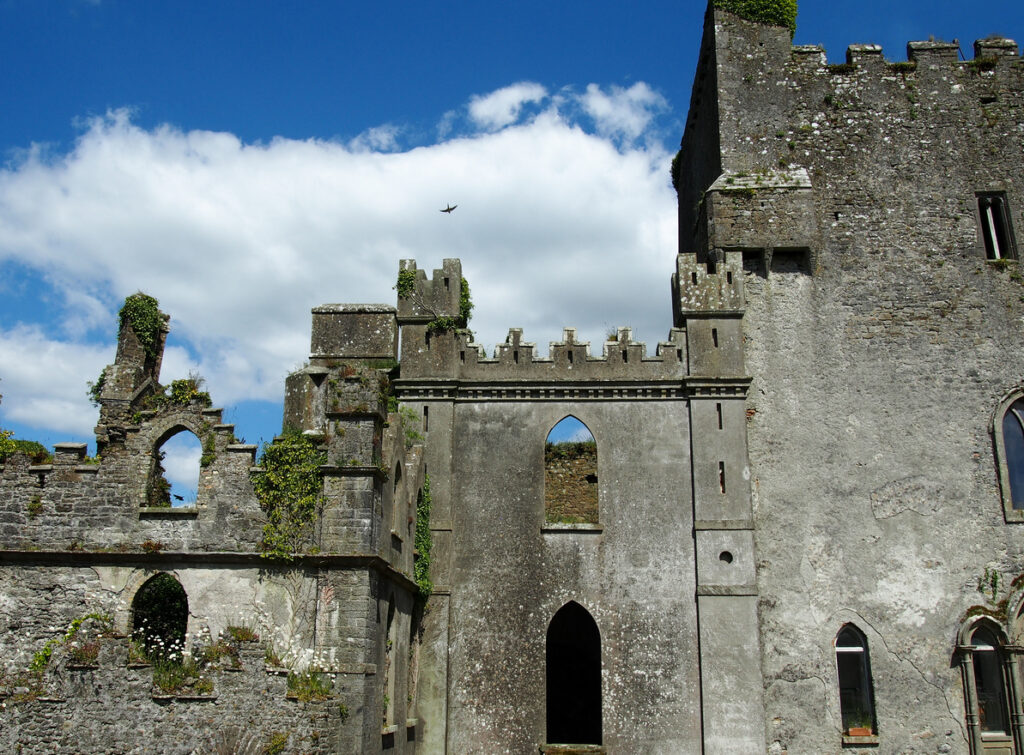
Leap Castle is one of the most haunted castles in Ireland. Standing atop a grassy hill in Ireland’s County Offaly, Leap Castle is more fortress than a fairytale. Built in the 13th century, it quickly earned a dark reputation thanks to generations of betrayal, power struggles, and brutal murders. The most infamous tale centers around the “Bloody Chapel,” where a fratricide stained its walls permanently. During a mass in the 1500s, one brother, a priest, was murdered by his own sibling and stabbed in the chest on the altar before the entire family. But that wasn’t the castle’s last horror. In the early 20th century, workers uncovered a hidden oubliette behind a wall filled with human bones impaled on iron spikes. It’s believed victims were thrown into the pit and left to die in agony, their screams echoing through the stone.
The castle’s most terrifying presence, however, is not one of its many ghosts but the so-called “Elemental.” Described as a small, humanoid creature with rotting flesh and the stench of sulfur, the spirit is said to predate the castle itself. It is rarely seen, but when it appears, it brings with it an overwhelming sense of dread and misfortune. Paranormal investigators, including TV crews, have documented cold spots, sudden camera malfunctions, and strange voices on tape. The current owner, who has been renovating the property since the 1990s, reports frequent unexplained activity but insists he’s made peace with the spirits. Whether it’s the centuries of bloodshed, the pagan roots beneath the stone, or something far older, Leap Castle continues to live up to its chilling reputation. Source: Wikipedia
14. Stull Cemetery – Stull, Kansas
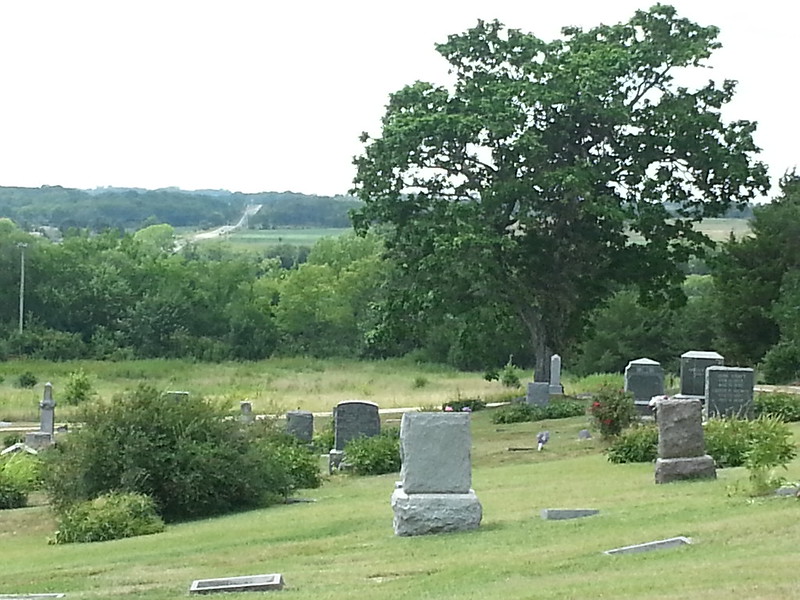
In the quiet farm country of eastern Kansas lies a cemetery so shrouded in rumor that it’s said to contain one of the seven gateways to Hell. Stull Cemetery, located between Topeka and Lawrence, appears unassuming from the road, with just a handful of weathered tombstones and a crumbling church foundation. But beneath its rural calm are decades of whispered stories involving witchcraft, satanic rituals, and the Devil himself. The most persistent legend claims that a stairway near the church ruins descends straight into the underworld, but it only opens twice a year: on Halloween and the spring equinox. Over the years, rumors of ghostly figures, inexplicable voices, and strange rituals have drawn curiosity-seekers and pranksters alike. The local sheriff’s department eventually had to increase patrols due to the constant occurrence of trespassing.
Despite attempts to dismiss the tales as urban myths, the story refuses to die. In the 1990s, it was widely rumored that Pope John Paul II had ordered his plane not to fly over eastern Kansas due to the alleged evil associated with Stull. Though this claim was never verified, it gave the cemetery international infamy. The ruined church was demolished in 2002 under mysterious circumstances, fueling even more speculation. Paranormal researchers have captured audio anomalies and temperature fluctuations around the site, and locals continue to report seeing odd lights and shapes moving between the gravestones at night. While there’s no record of a gateway to Hell being officially discovered, Stull Cemetery remains one of America’s most chilling and oddly well-guarded legends.
Source: Kansas City Star
15. Houska Castle – Blatce, Czech Republic
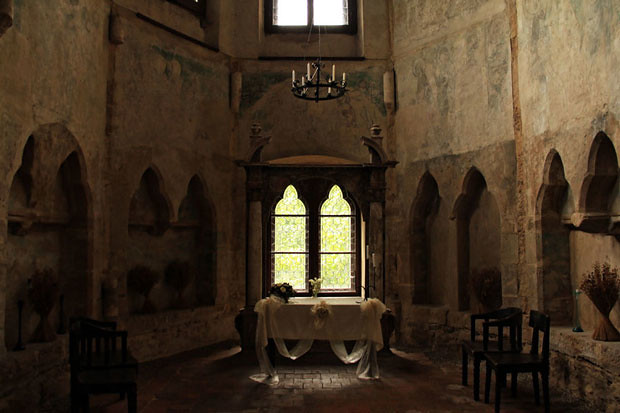
Built in the 13th century atop a remote cliff in the Czech countryside, Houska Castle was constructed for a strange reason—it wasn’t meant to defend against an external enemy but rather to seal something inside. According to legend, the castle was built over a massive, bottomless pit that locals believed was a direct gateway to Hell. Before construction, villagers claimed strange winged creatures emerged from the hole and dragged animals or people into the abyss. When the castle was built, its chapel was placed directly above the opening, with thick stone walls meant to trap whatever evil lurked beneath. There are no fortifications, no water source, and no strategic placement. In other words, it was never meant to house people. It was built like a lid on a tomb.
Over the centuries, Houska developed a reputation for paranormal activity. Visitors report hearing screams from beneath the floors, seeing shadowy figures in the corridors, and feeling sudden bursts of cold, even in the summer heat. Nazi forces briefly occupied the castle during World War II, allegedly conducting occult experiments there. Many believe they were drawn by the castle’s reputation and the legends surrounding the pit. After the war, locals discovered animal bones, bloodstained walls, and symbols carved into the stone, none of which were ever fully explained. Today, Houska Castle is open for tours, but even seasoned guides admit certain rooms are best avoided. Whether you believe in portals or not, the idea of a castle built not to protect but to imprison something inhuman makes Houska a uniquely terrifying place. Source: Atlas Obscura
Final Take: Where Legends Linger and Reality Blurs
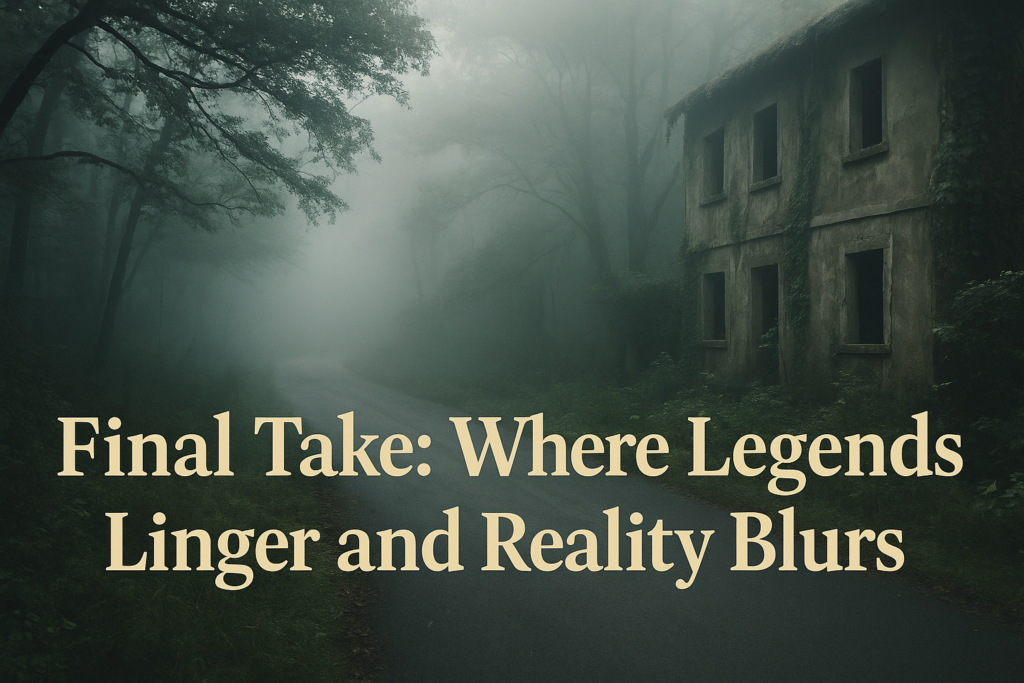
From crumbling castles to fog-draped forests, these places aren’t just backdrops for ghost stories—they’re the roots of the legends themselves. Each one holds layers of history, trauma, and local lore that continue to feed our imaginations. What’s most chilling is that many of these stories aren’t pure fiction. There are eyewitness accounts, police reports, unexplained phenomena, and, in some cases, entire towns that have been abandoned under mysterious or tragic circumstances. Whether it’s the methodical design of Houska Castle to trap evil or the burning ground of Centralia that still smokes decades later, these places blur the line between the real and the impossible.
Perhaps it’s a coincidence; maybe it’s a fear passed down through generations. Or possibly, some places really do absorb what happens to them, refusing to let go of the past. One thing’s for sure: these aren’t just haunted houses or creepy campfire tales. These are real-world coordinates where something once happened and may still be happening. If you’re brave enough to visit, don’t go alone.


